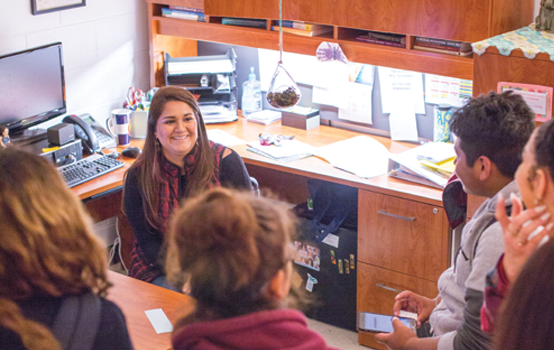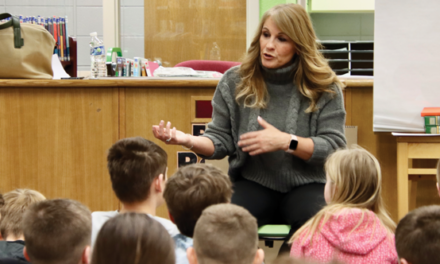
Inside the imposing concrete walls of the A. Philip Randolph In Schools, she gets to to learn trades and become prepared for college. For each of the past six years, she has also worked closely with about 65 students to manage support and services that go beyond the classroomCareer Academies in Jacksonville, Fla., Ingrid Thomas learns firsthand of the career aspirations of all 445 students who attend the school. As a school-based support coordinator for Communities know well the young people attending this career academy
“The majority of my students are from low-income families who not only need academic and career planning supports but also often benefit from access to health care, counseling, and even basic supports such as food, clothing, and school supplies,” said Thomas. “I meet with students, teachers, and their families to determine their needs and find the supports to help them be successful at this school.”
Thomas is one of more than 2,000 school-based support coordinators for Communities In Schools, the nation’s leading dropout prevention organization, providing what is known as Integrated Student Support services (ISS). Through its 155-affiliate oranizations, Communities In Schools (www.communitiesinschools.org) serves nearly 1.5 million students and families working in partnership with more than 2,300 school and community-based sites across the country.
Large urban school districts such as New York City, Houston, Miami, Chicago, Charlotte, Nashville, and Oakland, as well as smaller districts, have adopted ISS models as a way to target at-risk students’ academic and nonacademic barriers to learning. A 2014 Child Trends research report described ISS as a school-based approach to promoting students’ academic achievement and educational attainment by coordinating a seamless system of wraparound supports for the child, the family, and schools (Moore et al., 2014). Other national ISS providers include City Connects (www.bc.edu/bc-web/schools/lsoe/sites/cityconnects.html) and Children’s Aid Society Community Schools (www.childrensaidnyc.org/programs/community-schools).
Through varying models, these organizations play a vital role in helping at-risk students gain access to additional academic supports such as tutoring, enrichment and motivational activities, and college and career counseling as well as health care, behavioral interventions, and even food and clothing.
The work of the school-based coordinator
At the core of all these programs is the school-based support coordinator. These coordinators conduct needs assessments of the school and its students and then plan and provide supports in collaboration with community partner organizations, which can provide more specialized services not typically offered by schools.
Communities In Schools operates under an affiliate model, with funding typically coming from a combination of state, local, and federal sources as well as foundation grants and individual contributors (though some ISS programs, such as Oakland’s, are funded primarily by local school districts). Compensation for coordinators at Communities In Schools can range from $40,000 to $50,000 or more depending on market size, education level, experience, and other factors. In Oakland, the school community managers are unionized school employees who earn an annual salary of $67,000 to $85,000. They work all year, supporting summer programs when school is out.
Many school-based support coordinators help not just students but also their families.
“We take a comprehensive approach to helping every student succeed,” said Mary E. Walsh, executive director of City Connects, which works with 30,000 students in 11 cities, including Boston, New York, Minneapolis, and Hartford, Conn. “Our school-based site coordinators work with every student and teacher. Their role is to develop a personal plan of support for each student, based on their strengths and needs — academic, health, family, and social-emotional.”
Under the City Connects model, the site coordinator meets with each classroom teacher at the start of the school year to discuss the needs and data about their students. Following these meetings and in consultation with the principal, school nurse, and others, the coordinator develops a customized plan of school and community-based supports and opportunities for each student. The coordinators get to know the students and work closely with teachers, administrators, and parents to support students’ success.
“The whole-class review allows me to identify student needs and develop a plan for each student,” said Jaymie Silverman, a site coordinator for City Connects now in her third year at John Winthrop Elementary School in Dorchester, a Boston Public School. “For students at particular risk, I conduct individual student reviews, which provides the opportunity for our multidisciplinary teams to discuss the concerns in greater depth, create goals, and an intervention plan. The process allows me to look at the progress by student, grade level, and as a school.”
City Connects makes referrals to partner organizations to provide the services students need both inside and outside of the school setting. Research by Boston College’s Center for Optimized Student Support found that students who experience City Connects in elementary school later drop out of high school at about half the rate of comparison students who never experienced City Connects (Walsh et al., 2014).
Under the Communities In School model, school-based support coordinators work with school administrators and teachers to provide a range of universal supports such as arranging health checkups, planning career days, and bringing in academic tutors. They also work with school staff to identify students who are most at-risk and would benefit from more personal supports offered through a case-managed approach — in such cases, coordinators typically work directly with an average of 50 to 60 students during the school year, said Heather Clawson, executive vice president, research, learning, and accreditation for Communities In Schools.
“The first step is to establish relationships with school leadership and the teachers,” said Clawson. “Integrated Student Support models work best when the coordinator is viewed as part of the school environment and school culture. Relationship building with the school staff, students, and the students’ families is critical to success.”
In the 2015-16 school year, Communities In Schools provided case-managed services to 158,000 elementary, middle, and high school students across the United States. These included many English language learners, students enrolled in special education, homeless youth, and students living in foster care or having an incarcerated parent. Nearly 80% of these students were Hispanic or black, and 93% were from low-income families. According to Clawson, 99% of the case-managed students remained in school, 93% were promoted to the next grade, and 91% graduated from high school or earned a GED.
Oakland Community Schools, part of the Oakland Unified School District in California, has community school managers in 35 of its 86 schools serving some 15,000 students. “We support schools by creating a better environment for learning,” said executive director Andrea Bustamante. “Teachers know they have a partner to report a student concern, which allows them to focus on classroom instruction.”
To serve its students, community school managers in Oakland can tap more than 200 unique programs and services offered by the school district and partner organizations. These include after-school and parent engagement programs, health and counseling services, and academic tutoring. “Our principals say they could not run their schools as effectively without these school-community partnerships,” added Bustamante.
Organizations such as Communities In Schools and City Connects have program directors and managers who establish community-based partnerships that allow the coordinators to effectively make referrals for students and families they support. Partner organizations include groups such as Sight for Students, AmeriCorps, Boys & Girls Club, Goodwill, Feeding America, Big Brothers Big Sisters of America, YMCA, 4-H, and First Book. They also typically make referrals to local health agencies, food banks, clinics, and other community-based organizations.
Building parent relationships
All community schools have programs to engage parents more directly with the schools. For example, Oakland Unified has established a parent engagement team at its central office, and community school managers work closely with this team and participate in parent meetings and some home visits.
Communities In Schools’ coordinators meet with parents and guardians to discuss their child’s needs and gain approval to enlist the child in the case-managed program. Throughout the year, the school-based support coordinator maintains a regular flow of communication with the families of the students they serve, often serving as a bridge between school staff and a parent. This is especially true when there might be a cultural or language barrier, as in the case of the families served by Nadege Delinois-Jean, a Communities In Schools coordinator at North Miami School in Miami, Fla. “Many of the students at this school are from Haitian families,” said Delinois-Jean. “When I meet with them I can switch from speaking English to Creole. Immediately, I see them open their heart and treat me with such respect. It really helps build a comfortable and trusting relationship.”
At Jacksonville’s A. Philip Randolph Career Academies, site coordinator Ingrid Thomas holds regular game nights for parents at the school. She also makes home visits, and frequently calls and emails parents. “If one of my students is not in school, I want to find out why,” said Thomas. “I will call parents to see why their child is not in school and to address issues such as transportation or illness.” Thomas said that among the students she case-managed last year, nearly 100% graduated from high school.
Further, many school-based support coordinators help not just students but also their families by providing basic services such as food, clothing, and referrals for shelter when necessary.
Professional learning
Many of the school-based coordinators have master degrees, typically in social work or counseling. This is the case for all coordinators for City Connects and Oakland Community Schools, though Communities In Schools also employs coordinators who have worked as teachers, nurses, or in other social service positions.
Additionally, Communities In Schools has developed a virtual university to provide foundational training for new staff and professional development for existing staff. Courses address topics such as trauma and trauma-informed care, social, emotional, and academic development, developmental relationships, using data to inform practice, and many others. Local Communities In Schools affiliates also conduct in-person orientation and training for new coordinators and offer ongoing professional development.
Delinois-Jean has taken advantage of many of the professional trainings offered by Communities In Schools. “I took a peace-builder class that helped me learn to stay calm but also know when to be a commander,” she said. “Another great class was True Colors, which helped me recognize different personalities and how best to interact with each.”
City Connects’ summer institute for staff provides intensive professional development and coaching. Throughout the year, the organization provides ongoing professional development, coaching, and use of a technology system to facilitate matching school- and community-based resources to meet each individual student’s needs.
The Coalition of Community Schools (www.communityschools.org), which represents dozens of community schools managed by school districts, cities, and community-based organizations, provides an online network forum for school-based site coordinators where they can share knowledge, ask questions and get answers, and access resources.
Data-driven approach
A common denominator for all these programs is the systematic collection and analysis of data. For example, City Connects has created a Student Support Information System, which tracks classroom and student reviews, the services students and families are receiving, student grades, attendance, and academic and personal progress.
City Connects program manager Sara Davey said the system allows for an array of reports. “We can run a report to see what services are in most demand, the specific academic needs by classroom, if there are health issues impeding attendance. We can compare to other grades and schools,” Davey said.
Communities In Schools uses data and rigorous research findings to determine effectiveness, inform its trainings, and develop better programs to meet the needs of the students and schools, said Clawson, who oversees that work for the organization.
While site coordinators carefully track grade promotion and graduation rates of the students in their schools, it is often the positive relationships at the individual student levels that give them the most joy. “I am reminded of the value of City Connects when parents and guardians share their appreciation for my support and the services that I have connected their child to,” Silverman said. “More important, it’s the expression on students’ faces when they are excited about the new after-school program or learn a new skill or achieve a goal on their behavioral plan.”
Communities In Schools’ coordinator Thomas acknowledges it is a demanding job but also rewarding. “I go home every day knowing I have affected someone’s life,” noted Thomas. “It might have been as little as giving them a backpack, but it is huge to them. I helped someone live another day.”
References
Moore, K.A., Caal, S., Carney, R., Lippman, L., . . . . et al. (2014, February). Making the grade: Assessing the evidence for integrated student supports. Bethesda, MD: Child Trends.
Walsh, M.E., Lee-St. John, T., Raczek, A., Foley, C., & Madaus, G. (2014, Winter). Reducing high school dropout through elementary school student support. Boston, MA: Boston College, Lynch School of Education, Center for Optimized Student Support.

Comal County, Texas
Preparing for life after high school
Maria Maldonado overcame many obstacles on her way to graduating from high school in New Braunfels, Texas, and becoming a nurse. She moved from Mexico to Texas at age three with her single mother. When she started 1st grade, she still knew few words in English, and her family struggled financially.
This is when she first encountered Communities In Schools (CIS) of South Central Texas, a nonprofit program that works in 17 Comal Independent School District schools and in partnership with hundreds of community organizations to provide a range of supports to meet the academic and nonacademic needs of at-risk students. The sprawling 600-square-mile Comal County, which is 30 miles north of San Antonio and has a population of 124,000, is one of the fastest growing in the country.
“Communities In Schools provided me with school supplies, clothes, just about anything we needed,” Maldonado said. “In middle school, my vision was starting to fail. With help from the Communities In Schools’ coordinator I got glasses. In high school, I was bullied for being from Mexico. It was hard to take. I often would lean on my coordinator, Miss Liberty. She was always there for me. Her goal was not just to get me through high school but also into community college to study nursing.”
Miss Liberty is Liberty Nicholas who runs Project Success, a CIS program that helps high school students plan and prepare for college, careers, or service in the military. Project Success coordinators take high school students on field trips to colleges, businesses, hospitals, and other locations to learn about career options. They help students fill out college and financial aid applications. During the summer, Project Success alumni lead an eight-week boot camp — including a wilderness camping experience — to prepare about 45 high school graduates for life after high school. Site coordinators stay in touch with students after graduation as well, meeting with them at area colleges, texting them frequently, and keeping everyone connected through a Facebook page.
Maldonado is one of those alumni who gives back to the program by mentoring recent high school graduates. “Many of the students are first-generation kids like me,” said Maldonado. “They don’t have someone who knows about college. We tell them what it will be like and how to study.”
The Greater New Braunfels Chamber of Commerce secured state and local funding to introduce CIS in three schools in Comal County in 1993. Initially concerned about excessive absenteeism, which threatened state funding for local schools, the program eventually morphed into providing broader services for students and families, including those aimed at preparation for post-high school life. “While the program’s focus was on dropout prevention, little did we know the wide-ranging impact Communities In Schools would have with the children it served. The program deals with students’ needs outside of the classroom, giving teachers the time they need to teach. It has proven to be widely successful in helping raise graduation rates and getting kids off to a great career start,” said chamber president Michael Meek.
Today, Communities In Schools of South Central Texas has school-based support coordinators in nine elementary schools, five middle schools, and three high schools in Comal County. Coordinators provide supports to some 10,000 students and offer case-managed services to about 1,200 at-risk students. In the past school year, Communities In Schools documented 8,877 services to students and families, including clothing assistance, direct health services, basic needs and food assistance, health and safety awareness activities, and transportation to health services.
CIS of South Central Texas reported that 99% of the students it served in grades 7 to 12 stayed in school, 96% were promoted to the next grade, and 100% who were eligible to graduate received a high school diploma or GED.
“Our emphasis is on building relationships to change students’ lives.”
Carolina Navarro, the CIS site coordinator at the 2,800-student Canyon High School in New Braunfels, sees her job as being an advocate for students. “I work with students who often have a history of failing core classes,” she said. “I get to know them by building relationships. I meet with them once a week. I make sure they are turning in assignments, check on their grades, talk to their parents, get them thinking about college and staying involved with Project Success.”
Last year, 100% of the seniors she case-managed graduated from high school. Most are now enrolled in college or community college while one entered the military. “I’m excited to be here for four years and see all my students graduate. It is such a great feeling,” added Navarro.
“Project Success is a good fit for the Communities In Schools’ mission,” said Chris Douglas, CEO of the South Central Texas program. “Our emphasis is on building relationships to change students’ lives. When kids trust you, they will open their hearts to you, and they will share their struggles so you can help them with whatever they are facing.”
Charlotte, N.C.
Integrated student support makes a difference
North Carolina’s Charlotte-Mecklenburg School District faces many of the same challenges as other urban districts. More than half of its students are considered economically disadvantaged, many of its neighborhoods have experienced a dramatic rise in concentrated poverty, and the region has seen a large influx of immigrant children. Despite these challenges, however, graduation rates for students from low-income families have grown to 85.2% in 2016 from just 52% in 2009.
Then-Supt. Ann Clark attributes the gains to a district-wide focus on working with individual students to make sure they have a plan for life after high school and a course load that will get them there (Helms, 2016). “This has truly been a village effort,” Clark said.
The district also relies on a long-standing partnership with Communities In Schools of Charlotte-Mecklenburg, a nonprofit organization providing integrated student supports to 7,000 students in 45 elementary, middle, and high schools. More than two-thirds of the students enrolled in the CIS program come from poverty or low-income families. CIS takes a case-management approach to working with individual students and their families to address emotional, behavioral, and academic concerns, providing a wide range of supports such as academic tutoring, career counseling, enrichment activities, and referrals to community organizations for health services.
Central to the success of CIS is its ability to tap into a vast network of community partnerships to help students and families. Partners include organizations such as United Way, faith-based organizations, civic groups, philanthropic, and corporate organizations, and relationships with hundreds of volunteers. CIS in Charlotte-Mecklenburg has an annual budget of $7.5 million and is funded by the school district as well as county, state, and federal governments, corporations, foundations, and individuals.
Targeting student supports
Over the past few years, CIS has redoubled its efforts to meet the needs of students who have the highest risk of educational failure. These include students who experience incarceration, pregnancy, and high exposure to the many kinds of trauma associated with living in areas of concentrated poverty or coming to a new city as an unaccompanied minor.
“We know living and learning in high-poverty environments can add more stress to students’ lives and lead to more traumatic events,” said Molly Shaw, executive director of CIS Charlotte-Mecklenburg. “We work with the schools to identify students based on their unique challenges and then to offer them the right support, in the right amount, and at the right time.”
To provide these intensive supports, CIS has developed a tiered case-management approach for its site coordinators. For example, a site coordinator working with high-need students is assigned 20 to 30 students while other site coordinators serve many more students. This approach is proving effective. In the 2015-16 school year, CIS reported that among the students enrolled in its program, 99% stayed in school, and 96% were promoted to the next grade.
“I see CIS as being the wind beneath the wings of a kid,” Clark said. “Many of our kids are beating their wings pretty hard every day to stay in the air, and CIS comes along and takes care of the nonacademic barriers to a student’s successful flight. It’s thrilling to see what this organization has done for our community.”
Reference
Helms, A.D. (2016, September 2). CMS ratings: Confusing, contradictory, and cause for pride. Charlotte Observer.
Originally published in February 2018 Phi Delta Kappan 99 (5), 31-34. © 2018 Phi Delta Kappa International. All rights reserved.
ABOUT THE AUTHOR

Frank Walter
FRANK WALTER is president of Impala Communications, Washington, D.C.










